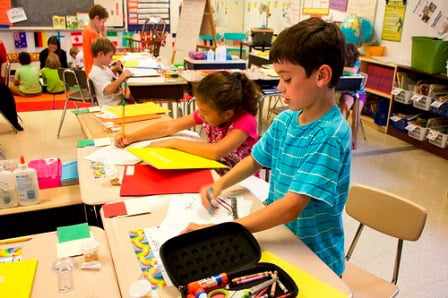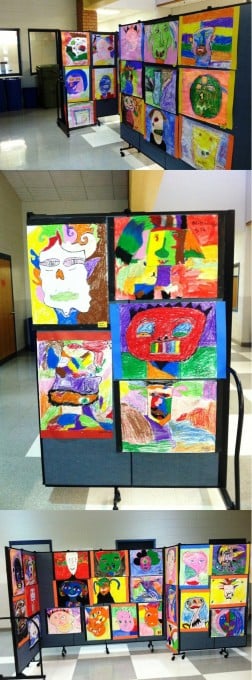The Next Picasso; Teaching Art to Children
Market: Art Displays
 At first, the idea of teaching art to children might seem like a daunting task, but if done correctly and with an open mind, is rewarding and fun. Although their skills may not yet be developed, what they lack in skill is certainly made up for in enthusiasm. Young children are still uninhibited and willing to experiment. Most importantly, they have not yet allowed themselves to be influenced by what others think of their work, nor are they trying to imitate the style of other artists. When teaching art to children try not to make lessons overly structured or complicated, and provide the right atmosphere and approach; it will make all the difference in the world.
At first, the idea of teaching art to children might seem like a daunting task, but if done correctly and with an open mind, is rewarding and fun. Although their skills may not yet be developed, what they lack in skill is certainly made up for in enthusiasm. Young children are still uninhibited and willing to experiment. Most importantly, they have not yet allowed themselves to be influenced by what others think of their work, nor are they trying to imitate the style of other artists. When teaching art to children try not to make lessons overly structured or complicated, and provide the right atmosphere and approach; it will make all the difference in the world.
Teaching Art to Children – Preparation
Young children don’t like to be corralled for long periods of time and become bored easily. It’s not hard to keep them focused; you just need to create a really great space that works for them.
- Choose an area large enough to accommodate supplies, with space for them to move around freely, and plenty of elbow room between students.
- Create an artistic vibe by showcasing a mix of artistic media, such as photos, paintings, sculpture, drawings, and architecture.
- Find a balance between the space being so cluttered with media that it is too distracting and so plain that they become uninterested.
- THIS IS SUPER IMPORTANT! Whatever can go wrong, will go wrong. Teaching art to children is sometimes a messy endeavor, so make sure their work area is on an uncarpeted hard surface that is forgiving of spills and splatter. If that is not possible, use drop cloths.
- Use a variety of materials and techniques that will allow them to experiment. Occasionally allow them to pick which materials and techniques they’d like to work with, just don’t give them too many choices.
Teaching Art to Children – Technique
Set them, and you, up for success. For your first lesson, choose a technique or concept that will be easier for them to master. Start simple with a something like dot painting, or show them the many ways you can manipulate watercolors using household items. Kids love this messy sort of projects and they usually make for great outcomes. Mastering these techniques will capture their interest and allow you to introduce more complicated techniques and change-up the materials. Once you have them interested, it might be time to introduce some art concepts and famous artists. Use very basic terms and don’t try to give them too many details about an artist, and be creative with what supplies you use to explain a concept.
Many years ago, I taught a monthly Art Appreciation pop-in class for elementary students at my kids’ school. One concept we explored was that of 3-D public art installations and I talked about Chicago’s recent Cows on Parade exhibition. I explained that it wasn’t really about the physical cow, but more the idea of personal expression; the only constants were that each person received an identical canvas and basic rules to follow, and then each artist expressed their creativity by transforming their cow form into anything they desired. We, of course, did not have the time nor resources available for a copycat parade. Instead, each student received identical (2-D) white tagboard cows and access to abundant, inexpensive, and unusual supplies. They were all given the same amount of time to complete the project, then the cows were displayed on their lockers. We held a school-wide “public viewing” and they remained on display for one month. It was such an easy concept for them to grasp and was a fast and basic project, so much so that they continued on with the parades for many years, choosing different shapes each year.
Another fun style to present is Cubism. Cubism created by Pablo Picasso (Spanish, 1881–1973) rejected the idea that art should copy nature. Instead, he captured snippets of people, objects or places, and placed them at unusual angles. If you a student likes to create using only one color, explain how the artist might go through periods where they express their moods by using only certain colors such as Picasso’s Blue or Rose periods. A fun way to let them pretend to be Picasso would be to allow them time to play with this fun digital tool.
 Teaching Art to Children – Display
Teaching Art to Children – Display
Make sure you have your students sign and date all of their work and if you can, hold an exhibit to display their creations. As you can see in this past blog post, Screenflex customers create beautiful displays using our products. Recently, a teacher from Virginia sent us a series of pictures showing how she displays her students’ work.
Teaching Art to Children – Have Fun!
However you decide to teach your students, just remember to have fun, and that Screenflex always has the perfect canvas on which to display their masterpieces!